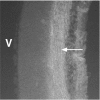DM-GRASP is necessary for nonradial cell migration during chick diencephalic development
- PMID: 10704504
- PMCID: PMC6772509
- DOI: 10.1523/JNEUROSCI.20-06-02287.2000
DM-GRASP is necessary for nonradial cell migration during chick diencephalic development
Abstract
Cell migration is fundamental to normal CNS development. Radial migration, along radial glial fibers, has been the principal pathway studied, however, nonradial or tangential cell migration has increasingly been identified at all levels of the CNS. Receptors, cell adhesion molecules, and extracellular matrix molecules have all been shown to participate in radial cell migration. In contrast, the molecular basis of nonradial cell migration has only recently begun to be elucidated. Using replication defective retroviral vectors we have determined the location and time when nonradial cell migration begins in the developing chick diencephalon. We have identified three molecules that are expressed in spatially and temporally restricted domains that are consistent with them playing a role in nonradial cell migration. One of these molecules, DM-GRASP, a transmembrane protein with five extracellular Ig domains, is expressed on the nonradially migrating cells in addition to axons. To test the hypothesis that DM-GRASP participates in guiding nonradial cell migration, we injected a replication-defective retroviral vector used for lineage tracing followed by a DM-GRASP blocking antibody. Embryos injected with the blocking antibody showed a near complete block in nonradial cell migration specifically where DM-GRASP is expressed. Furthermore, morphological analyses revealed disruption of the normal architecture of the diencephalon indicating nonradial cell migration is necessary for normal morphological development of the brain. Our data indicate that DM-GRASP is necessary for nonradial cell migration in the chick diencephalon and have provided a system to further explore the function of nonradial cell migration during CNS development.
Figures







References
-
- Anderson SA, Eisenstat DD, Shi L, Rubenstein JL. Interneuron migration from basal forebrain to neocortex: dependence on Dlx genes. Science. 1997;278:474–476. - PubMed
-
- Anton ES, Marchionni MA, Lee KF, Rakic P. Role of GGF/neuregulin signaling in interactions between migrating neurons and radial glia in the developing cerebral cortex. Development. 1997;124:3501–3510. - PubMed
-
- Asou H, Miura M, Kobayashi M, Uyemura K, Itoh K. Cell adhesion molecule L1 guides cell migration in primary reaggregation cultures of mouse cerebellar cells. Neurosci Lett. 1992;144:221–224. - PubMed
-
- Austin CP, Cepko CL. Cellular migration patterns in the developing mouse cerebral cortex. Development. 1990;110:713–732. - PubMed
Publication types
MeSH terms
Substances
LinkOut - more resources
Full Text Sources
